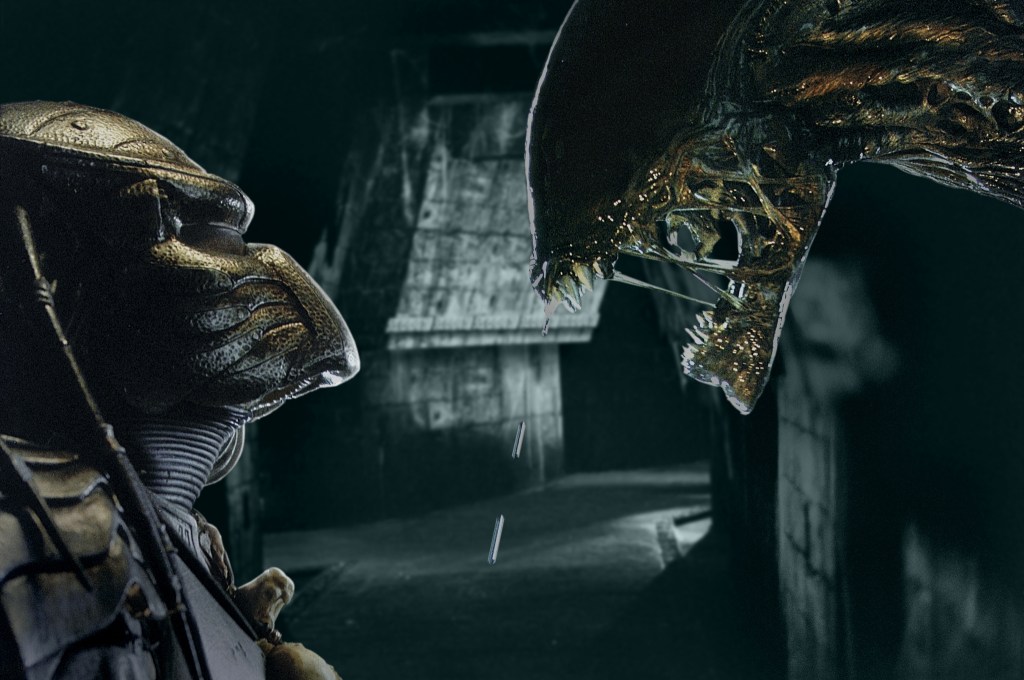I remember walking out of Alien vs. Predator feeling deflated, standing outside the theater, and wondering if perhaps I just wasn’t a big enough appreciator of either franchise to think the movie was incredibly cool. Hardcore fans seem to take a lot of issues with the continuity, pointing out logic issues and plot holes, or upset that AVP contradicts ideas they’ve always believed to be true about their favorite IPs. Other viewers who weren’t as invested or were willing to accept this excursion as a non-canonical adventure shut their brains off and had a blast with what they saw, but I was somewhere in the middle of these two groups and felt this big brawl under the ice didn’t do it for me, with plot or action. I keep meeting people willing to defend the movie, or who enjoy it, but only on the down low. Years later, however, I’m trying to look at AVP again without comparing it too harshly to the other quality entries, because part of me truly feels like I should like a lot of what it was trying to do.
The 2004 film was overseen by Paul W.S. Anderson, a man who directed my favorite movie of all time, and he’s a huge fan of both franchises, even if many people like to say his Alien-biased shows too much here. He wrote the screenplay, an idea he’d had for some time and even pitched before, but it took a while for the timing to line up. After the nod to the Alien franchise seen at the end of Predator 2 (1990), fans were excited about the eventual confrontation, but the idea to do stories where the two monsters met was already underway. Though they would clash in the comics in early 1990, the seeds for this battle were already appearing in late 1989. A movie script was submitted by Peter Briggs in 1991 and 20th Century Fox was eager to move forward with the project, but like what happens to many big-budget ideas there was a lot of interference and delays, especially when the company decided to work on Alien Resurrection (1997), an arguably worse film, first. By the time work on Alien vs. Predator started seriously in 2002 there had been at least two screenplay revisions – the first versions were much closer to the Dark Horse comics – and many people had been considered for and left the project before the crew was cemented, quite the task considering that up six or more producers had to agree on the decisions made since they affected two major franchises.
Several directors were considered for AVP, the most notable being Guillermo del Toro, who decided to focus on Hellboy (2004), leaving Anderson as the logical choice. It looked like Queen Latifah was considered to take on the main role at one point, a big fan of both franchises apparently, but scheduling issues from other projects forced her to give up the role. Rumor also had it that an early version of the script would feature a cameo from John Yutani, a role that both Peter Weller and Gary Busey were considered for, even though Busey had already appeared in Predator 2.
Sigourney Weaver, who played Ellen Ripley, seemed staunchly against the idea of a crossover like this, saying the idea “sounded awful,” which isn’t surprising from an actress who wanted her character killed off in Alien 3 (1992), and the Alien vs. Predator idea may have helped push her to that point. Arnold Schwarzenegger, however, who played Major “Dutch” Schaeffer, had agreed to film a cameo for the movie if he lost the upcoming gubernatorial election, but sadly, he won, so it never happened. This does put a point firmly in the Predator camp though and tells us which franchise was really there for the fans.
The cast we did get is interesting, but most people only remember that Lance Henriksen is in this one as Charles Bishop Weyland, a nod to the origins of his character from Aliens (1986). Sure, he’s more interesting as an android, but I appreciate his discussions about legacy and being sick, as well as the whole scene of him setting a Predator on fire to get some respect, “Don’t turn your back on me.” Sanaa Lathan (Blade’s mother) plays Alexa Woods, a veteran guide of harsh frozen environments who not only has to take on the “Ripley”-type role here but shares a lot with the Machiko Noguchi character from the comics, doubling the pressure. They auditioned a lot of women for her spot and it wasn’t an easy choice, but actors can only do so much with the script they’re given. We see some solid moments from Lex, but not everything with her character works, like trying to recreate the, “You are one ugly-“ line from the Predator films. Colin Salmon (Resident Evil, Arrow) is in it as well as Weyland’s right-hand man, another wonderful actor who just isn’t given enough to do here, in fact, there are a few other recognizable faces that almost feel wasted.
I hate to say it, but these characters are mostly forgettable, one of them was saddled with the nickname “Condom Woman” because she compared having her gun to needing a prophylactic and didn’t do much else until she died, and while the Italian Archaeologist is hot and endearing, he never had a chance, but if Ewen Bremmer (the Scottish chemical engineer) couldn’t get over by constantly mentioning his kids, none of these walking corpses could.
Viewers just want humans to be here for the slaughter, or in this case, make that dumb decision that helps give the Aliens the upper hand. But we kind of need them for exposition since the two extraterrestrial sides don’t talk much, hell the Predators don’t even do that weird voice mimicry in this one (I’m okay with that, actually). We can do some amount of character growth and emoting without them, the Alien known as Grid, due to the net pattern burned into his person, has a tiny arc and looks strong before being killed off haphazardly and we have a magical, almost romantic scene between Lex and Scar (our main Predator, who did have speaking lines in Anderson’s original draft) that shows bonding is done best through killing Aliens together and ritual scarring, but it’s hard to do an entire movie without a little story.
Somehow I’ve made it this far into the article without talking about the basic plot, and that’s because it isn’t that interesting. Weyland’s people detect a heat signature that leads them to a temple built by the Predators, meant to test their young warriors every hundred years. Aliens are intentionally released and the humans were purposefully drawn there to help test the newbies, so if I learned anything from this film, it’s that Predators and penguins are both assholes.
No, I’m not an Alien or Predator expert, but the more interesting part of the film was trying to answer people’s questions about plot holes or strange inconsistencies. I went on such a deep dive for a couple of things, that’s what this entire article almost became. Most of the questions are simply about why Predators choose to set things up this way, or how that surprise ending only works if we assume they can scan humans but not their own kind for impregnation. Some people get hung up on Alien gestation periods (Minutes? Hours? Days?) and exactly where they are supposed to burst out from, but there are a lot more questions, most centered on the flashback. How did eight sacrifices create that many aliens? Don’t Predators only come at the hottest times or is it that they just need hostile environments one way or the other? Why would Predators build one of their temples under the ice? Probably just constructed it a long time ago and they didn’t realize how much we were going to screw things up with climate change. The featurette helps answer some of these questions, explaining more about the scenes from the past at least, but I’m not expecting everyone to agree on these issues, especially since most were quick to call Alien vs. Predator non-canon.
The Unrated Edition of the film with more special features and eight extra minutes tacked on tries to help the story a bit, but not enough. It also added more blood, gore, and ‘slime,’ to try and offset one of the other big disappointments, the fact that AVP was rated PG-13 and mostly relied on colorful Alien and Predator blood to sell the combat. This meant that the theatrical release cut away from some of the violence and showed viewers the aftermath of human deaths more than the actual act, but what was added later still failed to sate bloodthirsty fans. There are rumors that Anderson said the movie was originally meant to be rated R, but this was heavily disputed and is now believed to be a rumor started by fans.
When our two main characters do fight in AVP it is mostly a great time. We see some excellent kills, especially when enemies get sliced in half or skewered, but the truth is that many of these executions lack any real weight or fanfare. Aliens use their acid and tails more while the Predators have bigger blades (since they are hunting more than humans) that can flip sides, giving us a few creative moments and making both sides feel more adaptive. I was a fan of how they disposed of the large Alien queen in particular. In the end, however, I think everyone wanted a little more Aliens fighting Predators or at least they could have drawn those parts out.
The movie isn’t scary and doesn’t do enough to build tension, but we did get some epic shots of the iconic monsters. There are neat details in what we see, mostly aping shots from the original films, stuff like having the altars in the sacrificial chamber resemble the pattern of the hibernation pods seen in Alien (1979). Some of the CGI hasn’t aged well, but I’d rather focus on the large number of practical effects, animatronics, and excellent models used for many of these shots that genuinely look wonderful, though some people don’t like the more armored Predator look, which was done to help hide performers in the suits. Some of Anderson’s trademark visual styles and camera tricks stick out, but they work, especially with the use of lighting and color. On the audio side, the score isn’t necessarily memorable and the ADR seems wonky in a few spots, but the most distracting things are a few of the sound effects used for the Predator’s lion-like roars and how the Alien appendages make knife sounds when wielded.
There are some other entertaining bits buried in the film that are just for hardcore fans. Most people will note that the movie we see on the monitor at the beginning is Frankenstein Meets the Wolf Man, one of the original famous monster confrontations, and Alien fanatics will certainly spot Weyland playing with his pen the same way Bishop does his knife trick, but there are many more. I didn’t notice the image of the Alien Queen in the satellite or realize that the character of Mark Verheiden was named after a creator of the Alien vs. Predator comics, and who would know that the Morse code spells out the film’s tagline, “Whoever wins, we lose.”
That’s how a lot of people felt after seeing Alien vs. Predator; that the fans lost. Critics weren’t happy with it either, but the movie did well at the box office, proving that people were still eager to witness this epic confrontation. It also performed well when it came to rentals and home videos, but some people didn’t truly appreciate it until the sequel came out. AVP has collected more fans over the years, even James Cameron, and I have to admit that seeing this one again has improved my feelings about it (just a little), even if I’ve had more fun researching the lore than watching the movie. People get different things out of watching divisive films like AVP and that’s cool, cold even, like space, where these two should have their next encounter.










